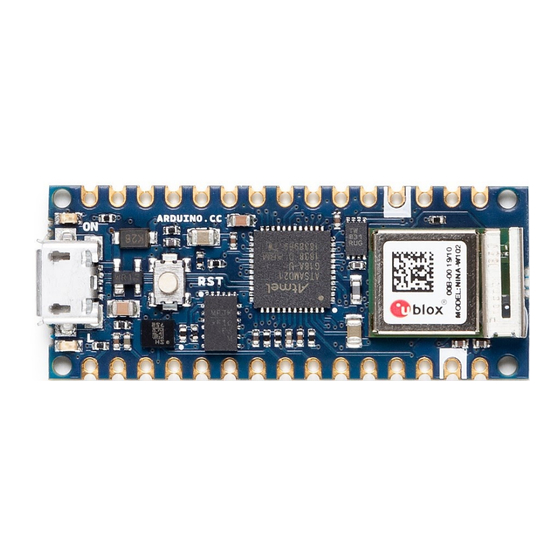
Table of Contents
Advertisement
Quick Links
Arduino® Nano 33 IoT
Product Reference Manual
SKU: ABX00027
SKU(with headers): ABX00032
Description
Nano 33 IoT and Nano 33 IoT with headers is a miniature sized module containing a Cortex M0+ SAMD21
processor, a WiFi+BT module based on ESP32, a crypto chip which can securely store certificates and pre-shared
keys and a 6 axis IMU. The module can either be mounted as a DIP component (when mounting pin headers), or as
a SMT component, directly soldering it via the castellated pads.
Target areas:
Maker, enhancements, basic IoT application scenarios
1 / 17
Arduino® Nano 33 IoT
Modified: 15/06/2022
Advertisement
Table of Contents

Summary of Contents for Arduino ABX00032
- Page 1 Arduino® Nano 33 IoT Product Reference Manual SKU: ABX00027 SKU(with headers): ABX00032 Description Nano 33 IoT and Nano 33 IoT with headers is a miniature sized module containing a Cortex M0+ SAMD21 processor, a WiFi+BT module based on ESP32, a crypto chip which can securely store certificates and pre-shared keys and a 6 axis IMU.
- Page 2 Arduino® Nano 33 IoT Features SAMD21G18A Processor 256KB Flash 32KB Flash Power On Reset (POR) and Brown Out Detection (BOD) Peripherals 12 channel DMA 12 channel event system 5x 16 bit Timer/Counter 3x 24 bit timer/counter with extended functions 32 bit RTC...
- Page 3 Arduino® Nano 33 IoT Nina W102 Module Dual Core Tensilica LX6 CPU at up to 240MHz 448 KB ROM, 520KB SRAM, 2MB Flash WiFi IEEE 802.11b up to 11Mbit IEEE 802.11g up to 54MBit IEEE 802.11n up to 72MBit 2.4 GHz, 13 channels -96 dBm sensitivity Bluetooth®...
-
Page 4: Table Of Contents
3.4 Crypto 3.5 IMU 3.6 Power Tree 4 Board Operation 4.1 Getting Started - IDE 4.2 Getting Started - Arduino Web Editor 4.3 Getting Started - Arduino IoT Cloud 4.4 Sample Sketches 4.5 Online Resources 4.6 Board Recovery 5 Connector Pinouts 5.1 USB... -
Page 5: The Board
USB or headers. NOTE: Arduino Nano 33 IoT and Nano 33 IoT with headers only supports 3.3V I/Os and is NOT 5V tolerant so please make sure you are not directly connecting 5V signals to this board or it will be damaged. Also, as opposed to Arduino Nano boards that support 5V operation, the 5V pin does NOT supply voltage but is rather connected, through a jumper, to the USB power input. -
Page 6: Functional Overview
Arduino® Nano 33 IoT 3 Functional Overview 3.1 Board Topology Board topology top Ref. Description Ref. Description ATSAMD21G18A Controller LSM6DSOXTR IMU Sensor NINA-W102-00B WiFi/BLE Module ATECC608A-MAHDA-T Crypto Chip Micro USB Connector IT-1185-160G-GTR Push button Board topology bottom 6 / 17 Arduino®... -
Page 7: Processor
I C peripherals (IMU and Crypto). NOTE: As opposed to other Arduino Nano boards, pins A4 and A5 have an internal pull up and default to be used as an I C Bus so usage as analog inputs is not recommended. -
Page 8: Crypto
3.4 Crypto The crypto chip in Arduino IoT boards is what makes the difference with other less secure boards as it provides a secure way to store secrets (such as certificates) and accelerates secure protocols while never exposing secrets in plain text. -
Page 9: Board Operation
4.4 Sample Sketches Sample sketches for the Arduino 33 IoT can be found either in the “Examples” menu in the Arduino IDE or in the “Documentation” section of the Arduino Pro website [4] 4.5 Online Resources... -
Page 10: Board Recovery
4.6 Board Recovery All Arduino boards have a built-in bootloader which allows flashing the board via USB. In case a sketch locks up the processor and the board is not reachable anymore via USB it is possible to enter bootloader mode by double- tapping the reset button right after power up. -
Page 11: Usb
Arduino® Nano 33 IoT 5.1 USB Pin Function Type Description Power Supply Input. If board is powered via VUSB from header this is an Output VUSB Power Differential USB differential data - Differential USB differential data + Analog Selects Host/Device functionality... -
Page 12: Debug
Arduino® Nano 33 IoT Pin Function Type Description D9/PWM Digital GPIO; can be used as PWM D10/PWM Digital GPIO; can be used as PWM D11/MOSI Digital SPI MOSI; can be used as GPIO D12/MISO Digital SPI MISO; can be used as GPIO 5.3 Debug... -
Page 13: Connector Positions
Arduino® Nano 33 IoT 6.2 Connector Positions The view below is from top however it shows Debug connector pads which are on the bottom side. Highlighted pins are pin 1 for each connector’ Top view: Top side connectors Bottom view:... -
Page 14: Certifications
7.2 Declaration of Conformity to EU RoHS & REACH 211 01/19/2021 Arduino boards are in compliance with RoHS 2 Directive 2011/65/EU of the European Parliament and RoHS 3 Directive 2015/863/EU of the Council of 4 June 2015 on the restriction of the use of certain hazardous substances in electrical and electronic equipment. -
Page 15: Conflict Minerals Declaration
Arduino® Nano 33 IoT 7.3 Conflict Minerals Declaration As a global supplier of electronic and electrical components, Arduino is aware of our obligations with regards to laws and regulations regarding Conflict Minerals, specifically the Dodd-Frank Wall Street Reform and Consumer Protection Act, Section 1502. -
Page 16: Company Information
Important: The operating temperature of the EUT can’t exceed 85℃ and shouldn’t be lower than -40℃. Hereby, Arduino S.r.l. declares that this product is in compliance with essential requirements and other relevant provisions of Directive 2014/53/EU. This product is allowed to be used in all EU member states. -
Page 17: Revision History
Arduino® Nano 33 IoT 11 Revision History Date Revision Changes 04/15/2021 General datasheet updates 17 / 17 Arduino® Nano 33 IoT Modified: 15/06/2022...















Need help?
Do you have a question about the ABX00032 and is the answer not in the manual?
Questions and answers